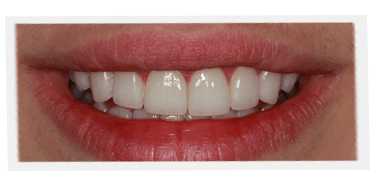
In previous articles, we looked at some of the fundamental principles of design. We saw how the eye responds positively to forms in nature that exhibit the “golden” proportions of geometry. And from there we looked at how those geometrical relationships form the foundation of beautiful smiles. Now it’s time to determine in more detail how the theory of design applies to actual smiles, and to develop principles of design that can be applied in practical ways by dentists when working on all types of cosmetic procedures, such as porcelain veneers, crowns, bridges, and dental implants. With that in mind, let’s look at the ten major principles of smile design. After that, we will conclude this series with a test that you and your dentist can use to score your smiles. The results may lead you to begin your own search for your perfect smile. (Taken below from my book, A Guide to the Perfect Smile.)
#1 Smile Line
The smile line is described by most dentists as involving the upper six front teeth against the lower lip. (I usually call these teeth the “social sox.”) Although this relationship is generally true, I have observed that the progression of the other teeth and the angles at which they follow, contrasted by the lips, must also be described. The rest of a person’s smile will animate differently based on whether their smile pattern is commissure, cuspid, or complex. See chapter two for descriptions of these different smile patterns.
Not everyone has a convex smile line. In fact, people with beautiful smiles have smile lines that follow their particular smile pattern. So the first principle is that your smile line needs to mirror, or as I like to put it silhouette, your smile pattern.
Once you or your dentist have identified your smile pattern, you can check in a mirror to see whether your smile line follows that pattern. There is no universal smile. Dentists are often told by patients, “I’ve had my teeth done and they look horrible on me. What happened?” The answer, in many cases, is that they may have been given a smile that does not silhouette their pattern. It’s similar to fashion – for example, checkered, double-breasted jackets may not be the best choice for short men.
#2 Relative Dental Proportions
In a beautiful smile, the teeth are proportionate in two ways. First, in and out of themselves, with each tooth having its own unique proportionate shape and form. And second, in how they fit with their adjacent teeth to be viewed collectively as one smile. What this means, for example, is that the maxillary front incisor should, first, be 20% taller than it is wide. Second, the two maxillary front incisors need to be viewed as one collective unit and have a width-to-height ratio of 1 to 1.6. If the average person has a tooth that is 10mm in height, the width of the two teeth together should be 16mm.
Generally, as you look at your teeth straight on, your widest and longest teeth should be the two top front teeth at the midline. To the eye, the rest of the teeth should diminish in size as they cascade toward the back. I say “to the eye,” because if you actually removed the cheeks and looked at the teeth straight on, a molar may in fact be wider then a front tooth – it just looks smaller at the angle from which it is usually seen. Sometimes you see a person whose back teeth look too big. Their smile does not look right because those teeth do not cascade to appear smaller as the eye looks down the smile line.



